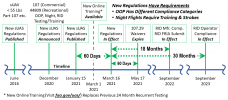The 107.29 text is one of the most clearly worded and unambiguous items of all the regulations.
As
@gschulzuio mentioned, the new training becomes available March 1 that will enable to you to fly at night starting on March 16th or as soon as you've completed the online recency training. Which ever occurs later.
Also, no need to get it in writing from your FSDO, the link I provided previously already has a link in it to the documented upcoming changes in the Code of Federal Regulations. I'll copy it here:
Electronic Code of Federal Regulations (eCFR) published by the Government Publishing Office
www.ecfr.gov
14 CFR--PART 107
View Printed Federal Register page
86 FR 4382 in PDF format.
Amendment(s) published January 15, 2021, in 86 FR 4382
Effective Dates: Mar. 16, 2021
14. Amend §107.29 by revising the section heading and paragraphs (a) and (b) and adding paragraph (d) to read as follows:
§107.29 Operation at night.
(a) Except as provided in paragraph (d) of this section, no person may operate a small unmanned aircraft system at night unless—
(1) The remote pilot in command of the small unmanned aircraft has completed an initial knowledge test or training, as applicable, under §107.65 after March 1, 2021; and
(2) The small unmanned aircraft has lighted anti-collision lighting visible for at least 3 statute miles that has a flash rate sufficient to avoid a collision. The remote pilot in command may reduce the intensity of, but may not extinguish, the anti-collision lighting if he or she determines that, because of operating conditions, it would be in the interest of safety to do so.
(b) No person may operate a small unmanned aircraft system during periods of civil twilight unless the small unmanned aircraft has lighted anti-collision lighting visible for at least 3 statute miles that has a flash rate sufficient to avoid a collision. The remote pilot in command may reduce the intensity of, but may not extinguish, the anti-collision lighting if he or she determines that, because of operating conditions, it would be in the interest of safety to do so.
* * * * *
(d) After May 17, 2021, no person may operate a small unmanned aircraft system at night in accordance with a certificate of waiver issued prior to March 16, 2021 under §107.200. The certificates of waiver issued prior to March 16, 2021 under §107.200 that authorize deviation from §107.29 terminate on May 17, 2021.





